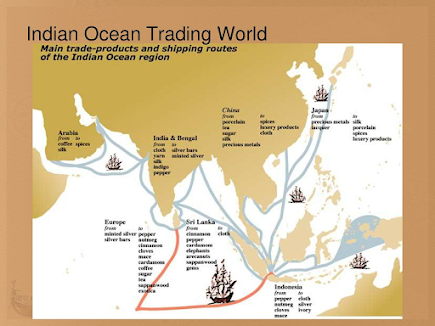Swahili women generally wear brightly
colored and patterned rectangular cotton cloths called kanga. Women will
cut a kanga in half, wrapping one half around their waist like a skirt,
and the other half around their shoulders and head (as a Muslim head
covering). Kangas originated in the 19th century on the
Swahili coast, where women would buy Portuguese handkerchiefs and sew
them together to get a larger rectangle of cloth (similar to an Indian
sari, which is also a large rectangle of cloth). Eventually, merchants
began selling large rectangles of cloth – a true kanga.
Kangas have Swahili sayings on them – at first,
these sayings were printed in Arabic, but now, they are printed in Roman
letters (the English alphabet). A kanga is similar to a t-shirt in that
it can be used to make a political, religious, or cultural statement.
3. What cultures combined to create the kanga?
This map shows many of the items traded in the Indian Ocean Trade Network:
4. What part of the world does the cotton used to make kangas likely come from? How does it get to the Swahili coast?
5. Explain how the kanga is an example of cultural blending.
Some wealthier Swahili women wear a floor-length
black dress called a bui-bui, which is worn over western-style clothing
(pants or dresses). Bui-buis are usually worn outside the home. Bui-buis
come with an attached headscarf (hijab), although some women choose to
wear a more colorful hijab instead.
Above, a Swahili woman wearing a bui-bui and colorful hijab.
6. What other types of Muslim womens’
clothing resemble bui-buis? What parts of the world do you generally see
those traditional Muslim clothes?
Men who live on the Swahili coast generally dress
in western clothing, but some men wear more traditional clothing,
especially on Friday, the day when Muslims pray at a mosque. Men will
wear a kanzu, or ankle-length white tunic. Men also wear, even without a
kanzu, a koffiya, or Muslim prayer cap. These are often white with tan
stitching.
Above, a Swahili man in traditional Muslim prayer clothes.






